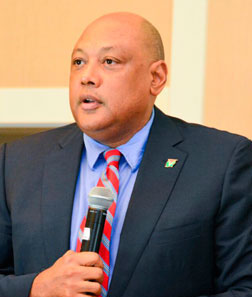Challenging the assertion by the Guyana Gold Board (GGB) in the headline of the Stabroek News story of Sunday May 25th that “unknown” forces were smuggling gold out of Guyana, a source close to the industry told Stabroek Business earlier this week that “nothing could be further from the truth.” Gold smuggling, the official asserted is being carried out “by people who are legally involved in the trade,” the source said, even though he added that the illegal movement of gold out of the country “also involves international players.”
The alarming financial loss to the public treasury arising out of the illegal export of gold first hit the headlines more than three years ago when, early in 2016, Natural Resources Minister Raphael Trotman made the alarming disclosure that illegal gold exports amounted to around 15,000 ounces of gold per week, a rate of smuggling which meant that Guyana was losing between 50 to 60 per cent of its gold production to the illegal export of gold.
The extent of official alarm over the smuggling practice was reflected in the fact that the local authorities opted to call in the US Federal Bureau of Investigation (FBI) which reportedly confirmed that Guyana, among other countries in the region, was losing significant amounts of gold to highly organised smugglers. No one, at that stage, ever doubted that the gold smuggling phenomenon would severely challenge the capacity of the authorities here to respond effectively and that would appear to have been precisely the case.
The disclosure in the May 25th Stabroek News article that the Gold Board was moving to increase its presence in mining districts and to raise its game as far as the sealing of gold for exports was concerned, provided confirmation that three years after the smuggling alarm had been sounded, the practice persisted unabated and that the volumes of gold being illegally exported might have risen above the figures provided in 2016.
Ominously, the Guyana Gold Board had stated in a Friday May 24th article written for the Stabroek News that
“on a comparative basis, the quantity of gold coming to the Gold Board has declined,” and that “consistent reports and intelligence are that activities in the mining sector and the corresponding production levels do not match the amounts being declared at the Gold Board locations.” That, in effect, amounted to saying that gold smuggling was continuing unabated, the efforts of the authorities to rein in the smugglers notwithstanding.
The essence of the Gold Board’s response to its own admission that smuggling was continuing to move apace was that it had “begun to go into the mining districts to buy the precious metal while also tightening up security measures for exports.” That, this newspaper’s source declared, “isn’t really saying much,” given what was described as the “resources and influential network” involved in the smuggling. “These guys are batting on a playing field that is bigger than just Guyana,” the source said.
Setting aside what is widely believed to be a highly sophisticated hemispheric gold-smuggling infrastructure, the source’s assertion would appear to be based on wider evidence of a strong global gold-smuggling infrastructure of which, it seems, Guyana has become a part.
A matter of just a few weeks ago a Reuters report from the Kenyan Capital, Nairobi, alluded to “billions of dollars’ worth of gold …being smuggled out of Africa every year through the United Arab Emirates which it said was serving as “a gateway to markets in Europe, the United States and beyond.” Quoting from “Customs data” the report asserted that in 2016 alone, the UAE had imported US$15.1 billion worth of gold from Africa. The total weight of the imports, the report said, was 446 tonnes, up from 47 tonnes in 2016. Significantly, according to the Reuters Report, much of this gold had not been recorded in the exports of African states, a circumstance which it said indicates that “large amounts of gold are leaving Africa with no taxes being paid to the states that produce them.”
Whereas in Africa, assessments of the volume of illicit gold trade can be approximated by comparing total imports into the UAE with the exports declared by African countries, the Guyana Gold Board has no such barometer at its disposal which is precisely why this newspaper’s source asserts that the 50-60% of production estimated loss to smugglers is, “at best, a guesstimate.”
The Gold Board’s assertion that the smuggled gold “is going somewhere” and that the practice is serving to imperil the well-being of Guyana, is of course, not news to either the industry or to the country as a whole. Its pronouncement that it intends to “move closer to the point of discovery” by going out into the field and meeting the mining constituency raises questions about its capacity to cover the vast expanses of territory over which gold is mined in Guyana. While the Board says in its Stabroek News column that it is “being proactive and extending a service to the lesser served in the sector” whilst “expending energy and scarce resources to address a shortfall in its projections,” its capacity to rein in the smugglers given what is almost certainly the considerable investment and external involvement in smuggling operations, is questionable. Beyond that, the Gold Board column alluded to the desirability of the need for an oversight presence “that seeks to fulfil the interests of those who have complained about being underserved, taken advantage of, and left to their fate,” a pronouncement that leaves open to speculation issues pertaining to integrity considerations within the agency itself.
In March last year the Stabroek Business reported that the Ministry of Natural Resources was engaging a UK-based company, Focus Link Ltd, in discussions that could lead to the installation of a hi-tech system that will shore up the integrity of the sector’s monitoring and regulatory regime. The envisaged project initiative, titled AXIS Guyana, reportedly seeks to work with statutory and support agencies in the sector including the GGMC, the GGB, the Guyana Revenue Authority (GRA), the Bank of Guyana and the State Assets Recovery Agency (SARA), one of its primary objectives being the creation of a one-stop shop that brings users, regulators and related agencies in the sector together under a regime that requires all statutory users to set up their profiles and submit periodic returns and which enables regulators to monitor and quickly flag submitted data. Critically, AXIS is expected to provide efficient and reliable access to data on gold production and sales by mining entities, a facility that is expected to better position the GGB to spot irregularities and move towards closing loopholes.
Up until that system is up and running and properly tested, the country’s crucial gold-mining sector seems set to remain highly vulnerable to what, by the admission of the authorities, remains a seriously debilitating regimen of smuggling that continues to drain the country of crucial foreign currency earnings.
Stabroek Business understands the Cabinet has already approved the AXIS arrangement and that work on its implementation is awaiting the completion of a contract with the GGB.









